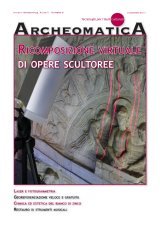RICOMPOSIZIONE VIRTUALE DEL TABERNACOLO DI ISAIA DA PISA PER LA CHIESA DELLA SS. TRINITà€ DI VITERBO
DOI:
https://doi.org/10.48258/arc.v2i4.91Keywords:
LASER SCANNING, MODELLAZIONE 3D, REALTà€ VIRTUALE, STORIA DELL'ARTEAbstract
Questo progetto ha preso spunto da uno studio condotto da Giusy Zevolini e pubblicato nel 2003 sulla Rivista dell'Istituto Nazionale di Archeologia e Storia dell'Arte. Nell'articolo la studiosa proponeva un'ipotesi di ricomposizione di due opere scultoree in marmo, entrambe eseguite durante il XV secolo, una delle quali sicuramente dall'artista toscano Isaia da Pisa. Le due parti, in origine probabilmente inserite in un unico complesso scultoreo monumentale, all'interno della chiesa agostiniana della SS. Trinità di Viterbo, oggi sono conservate in due siti distinti del capoluogo del territorio della Tuscia.
Virtual Reconstruction of the Tabernacolo of Isaia da Pisa for the Church of SS. Trinità in Viterbo
This study is based upon a characteristic, Art History paper, published in 2003. Specifically it suggests a reconstruction hypotesis concerning two marble objects, created in the XV Century, which were supposed to belong to each other, in a monumental complex, inside the Augustinian Church of the SS. Trinità in Viterbo (Italy). In the article the iconography was rendered by simply stitching pictures together, losing the objects proportions, without any care given to the likely missing parts, and of course showing the image in 2D. Despite scholars mostly agreeing that the two marble artefacts were made by the same artist (Isaiada Pisa) and that both belong to the same church, they are still notsure if the pieces are a unique structure. The virtual re-composition helps to enhance the visual perception of the whole construction, which is now available just in 2D flat images, and to understand how it originally would have looked. The two objects, today placed in different locations in the city of Viterbo, studied in this paper are: a marble tabernacle with Angels and Christ; a marble tympanum with a blessing by Christ. Both sculptures were acquired witha triangulation laser scanner in two different surveys in Viterbo: the first one, at the Church of the SS. Trinità , was carried out in August 2010 and the second one, at the Civic Museum, in February 2011. The well-known 3D post processing pipeline for laser scanner data was applied. The software used for the post processing was MeshLab 130a, 64bit version. In the final step all three dimensional models have been recomposed in a unique context. At a glance, the first thing that appears clear is how the monument made by Isaiada Pisa was massive and impressive in dimensions. Assuming an average height of the tabernacle of one meter and half from theground, its vertical pattern was around 4 meters. The importance of the work, as well as its size, is also supported by archival documentation which records the presence of an important artist like Isaia da Pisa in Viterbo. This case study shows in a practical way the importance of interaction and brainstorming between Art History/Archaeology specialists and experts in computer science (especially in three-dimensional modelling) working in a multidisciplinary context where the different expertises cannot be separated from each other. The reconstruction of the Tabernacle of the Virgin is part of a still on-going project.
References
Zevolini G., (2003), Il Tabernacolo di Isaia da Pisa per la Chiesa della SS. Trinità di Viterbo: un'Aggiunta ed una Proposta di Ricomposizione, Rivista dell'Istituto Nazionale di Archeologia e Storia dell'Arte, 58 III serie, XXVI
Guidi G., Remondino F., Russo M., Voltolini F., Rizzi A., Menna F., Masci M.E., Benedetti B., (2008), A multi-resolution methodology for archaeological survey: the Pompeii forum, Conference, Virtual System and Multimedia
Dedicated to Digital Heritage(VSMM), Limassol, Cyprus, October 20-26
Godin G., Rioux M., Beraldin J.-A., Levoy M., Cournoyer L., (2001), An Assessment of Laser Range Measurement of Marble Surfaces. Proceedings of the 5th Conference on Optical 3-D Measurement Techniques, 49-56, Vienna, Austria
Guidi G. Remondino F., Russo M, Spinetti A., (2009), Range sensors on marble surfaces: quantitative evaluation of artifacts. Videometrics, Range Imaging and Applications X, Proc. of SPIE Optics+Photonics, Vol. 7447, 2-3 August, San Diego, CA, USA
El-Hakim S., Beraldin J.-A., Picard M., Cournoyer L., (2008), Surface reconstruction of large complex structures from mixed range data – the erechtheion experience, The International Archives of the Photogrammetry, Remote Sensing and Spatial Information Sciences. Vol. XXXVII. Part B5
Guidi G., Remondino F., Morlando G., Del Mastio A., Uccheddu F., Pelagotti A., (2007), Performance evaluation of a low cost active sensor for cultural heritage documentation. 8th Conference on Optical 3D Measurement Techniques, 59-69, Vol.2, Zurich, Switzerland
Guidi G., Russo M., Beraldin J.A., (2010), Acquisizione 3D e modellazione poligonale, McGraw-Hill, 211-212
Bolitho M., Hoppe H., Kazhdan M., (2006), Poisson Surface Reconstruction, SGP'06 Proceedings of the fourth Eurographics symposium on Geometry processing Eurographics Association.
Downloads
Published
How to Cite
Issue
Section
License
Gli autori che pubblicano su questa rivista accettano le seguenti condizioni:- Gli autori mantengono i diritti sulla loro opera e cedono alla rivista il diritto di prima pubblicazione dell'opera, contemporaneamente licenziata sotto una Licenza Creative Commons - Attribuzione che permette ad altri di condividere l'opera indicando la paternità intellettuale e la prima pubblicazione su questa rivista.
- Gli autori possono aderire ad altri accordi di licenza non esclusiva per la distribuzione della versione dell'opera pubblicata (es. depositarla in un archivio istituzionale o pubblicarla in una monografia), a patto di indicare che la prima pubblicazione è avvenuta su questa rivista.
- Gli autori possono diffondere la loro opera online (es. in repository istituzionali o nel loro sito web) prima e durante il processo di submission, poiché può portare a scambi produttivi e aumentare le citazioni dell'opera pubblicata (Vedi The Effect of Open Access).





